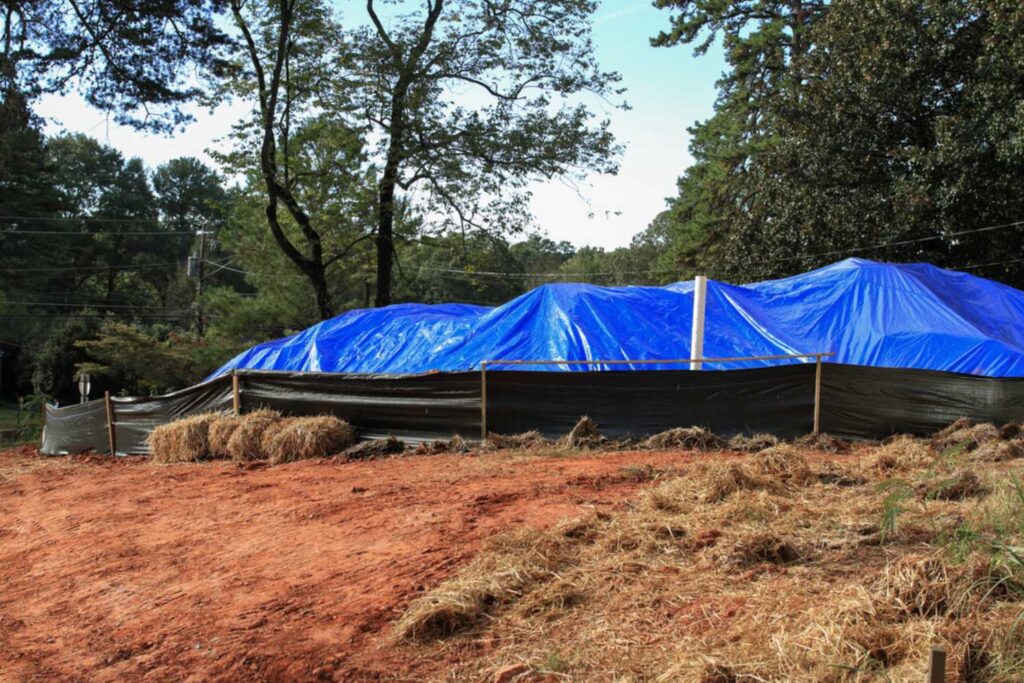7 Silt Fence Installation Considerations to Remember

Silt fences are a simple but effective tool to stop the movement of sediments. Construction works can disturb the soil and cause unwanted sediment movement that erodes nearby terrain and pollutes watercourses. Informing yourself on tips to consider when installing a silt fence can help you create the perfect barrier.
Ecospill helps contractors install silt fencing by providing quality materials and instructions. In this article, we list seven silt fence installation considerations to note for when you install a silt fence.
7 SILT FENCE INSTALLATION CONSIDERATIONS
Below we list seven silt fence installation considerations to aid you in erecting the perfect fence:
1. Optimal height
The height of the fence should be tall enough to support the trapped sediment but short enough to maintain stability. Your fence material will sit in the trench, so the height of the fence will be less than the height of the material. The ideal height of the silt fence depends on the slope or the amount of sediment expected to run into the barrier.
If you’re on a relatively flat site (under a 6% slope) or don’t expect much sediment runoff, a 40cm silt fence height will be adequate. Fences on steeper slopes should have a taller height but shouldn’t be higher than 70cm. This is to avoid the risk of the fence holding too much sediment that it fails or flooding the fence.
2. Optimal post type
Your posts should be strong enough to hold your fence upright and maintain its stability as sediment builds up on the fence material. Hardwood timber posts are a popular choice because of their strength and durability. Square shaped posts that have an angled cut at one end (also known as stakes) are ideal.
The square shape gives them an even cross-sectional area which means they can handle loads from each direction. It also provides a large area for the material to be stapled to the posts. The staked end allows you to hammer them into the ground easily. As some environments have hard ground, staked edges will enable them to be inserted manually.
3. Optimal post spacing
The post spacing is one of the most essential silt fence installation considerations because it can support the fence’s stability. When installing the posts, the optimal spacing is 1.5m apart. For high flow areas, you can space them 1.2m apart. This distance allows the material to be taut and secure, allowing the fence to remain upright while sediment or water is trapped.
If the spacing is any further apart, the runoff may find spaces underneath the fence to pass through and erode the soil. Following this guidance may cause you to use more posts than you anticipated, but the silt fence will protect your site for longer.
4. Optimal post length
Fence posts need to be inserted into the ground far enough to enhance the strength of the fence. The height of the posts should be around 40cm taller than the height of the fencing material. After this 40cm is inserted into the ground, the top of the posts will be the same height as the top of the material.
5. Silt fence positioning
You should install your fence before any soil disturbance begins and in an optimal position for maximum effectiveness. Installing a silt fence down-slope from the construction works or stockpile is the best practice. Try to install them along the slope’s contour so that they remain the same height over the entire length. Insert the two end posts slightly uphill of the penultimate posts. This will create a bend at the ends to hold sediment within the fence.
6. Silt fence material
Silt fence materials are a permeable fabric that helps capture sediment and reduce water flow. They should be heavy-duty to trap the sediment runoff effectively. However, they should also allow water to pass through to reduce the weight of the trapped sediment and maintain its structural integrity. Ecospill’s provides silt fence material that you can cut to any length so you can position your fence wherever you need.
7. Wire backing (reinforcement for silt fence material)
One of the final silt fence installation considerations is to apply a wire backing to the fence material. This can provide extra strength to help the silt fence maintain its integrity. If you’re expecting your site to produce a large amount of runoff, a wire backing can give the fence the extra durability it needs. When installing the wire backing, staple it to the fence posts to provide lateral support.
Wrapping Up
Silt fences provide an enormous benefit for a simple expense. These silt fence installation considerations should help you get the most efficient and prolonged use out of them. Before installing your fence, make sure you have the optimal materials and expert knowledge so they can protect your site correctly. Ecospill supply high-quality silt fence materials for fast installation. If you have any questions about our silt fences, then give us a call.
